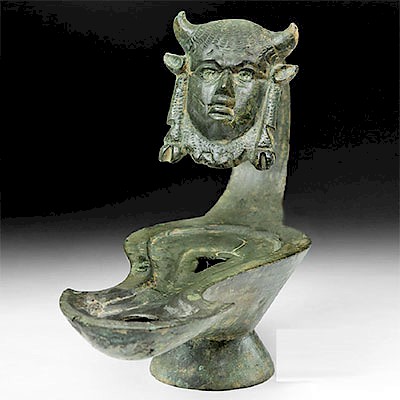18th C. Indo-Persian Paintings on Paper (group of 6)
Lot 101
About Seller
Artemis Gallery
686 S Taylor Ave, Ste 106
Louisville, CO 80027
United States
Selling antiquities, ancient and ethnographic art online since 1993, Artemis Gallery specializes in Classical Antiquities (Egyptian, Greek, Roman, Near Eastern), Asian, Pre-Columbian, African / Tribal / Oceanographic art. Our extensive inventory includes pottery, stone, metal, wood, glass and textil...Read more
Estimate:
$800 - $1,200
Absentee vs Live bid
Two ways to bid:
- Leave a max absentee bid and the platform will bid on your behalf up to your maximum bid during the live auction.
- Bid live during the auction and your bids will be submitted real-time to the auctioneer.
Bid Increments
| Price | Bid Increment |
|---|---|
| $0 | $25 |
| $300 | $50 |
| $1,000 | $100 |
| $2,000 | $250 |
| $5,000 | $500 |
| $10,000 | $1,000 |
| $20,000 | $2,500 |
| $50,000 | $5,000 |
| $100,000 | $10,000 |
| $200,000 | $20,000 |
About Auction
By Artemis Gallery
Sep 27, 2018
Set Reminder
2018-09-27 10:00:00
2018-09-27 10:00:00
America/New_York
Bidsquare
Bidsquare : Antiquities | Asian | Ethnographic
https://www.bidsquare.com/auctions/artemis-gallery/antiquities-asian-ethnographic-3469
Featuring classical antiquities, ancient and ethnographic art from cultures encompassing the globe. Artemis Gallery info@artemisgallery.com
Featuring classical antiquities, ancient and ethnographic art from cultures encompassing the globe. Artemis Gallery info@artemisgallery.com
- Lot Description
Central Asia, India / Persia, ca. 18th to 19th century CE. A group of six finely painted paintings on paper, created with opaque pigments as well as gold leaf and depicting regal court scenes with decorative borders. The compositions included in this ensemble are: a royal couple beside a flowering tree - the female watering it, the male holding a book and looking askance; a male equestrian figure; a couple outside the palace walls and watering a blossoming tree; an amorous couple engaged in an embrace just outside the palace; a regal figure in blue plucking a fruit from a tree branch; and a finely dressed regal standing amidst flora. Size: 12.25" L x 7.625" W (31.1 cm x 19.4 cm)
Miniature painting emerged in Persian art during the 13th century. Following the Mongol conquests, the genre displayed strong Chinese influence, and the tradition reached its peak during the 15th and 16th centuries. Furthermore, Persian miniature painting influenced other Islamic miniature traditions, including the Ottoman miniature created in Turkey as well as the Mughal miniature of India.
Interestingly, Persian art - although under the influence of Islam - never completely forbade the inclusion of the human figure. Furthermore, the depiction of figures - oftentimes in groups - is a common practice in the miniature tradition. Scholars believe that this was because the miniature was used as a private form of visual culture. These images were kept in a book or an album and only shown to a select audience. For this reason, artists could be more free when creating miniatures than when creating wall paintings which were viewed by a wider audience. The Koran (Qur'an) and other religious texts were not illustrated in this way as a rule; however, other works of literature and histories at times included religious scenes, some with depictions of Muhammed, although those rendered after 1500 usually do not present his face.
Mughal painting refers to a type of miniature painting - either serving as book illustrations or created as single work. The term miniature suggests a tiny scale; however, it actually indicates a style of watercolor work similar to early European book illustrations that used the red pigment minia. Some Indian miniatures are in fact quite large. The Mughal style stems from Persian miniature painting, though with Indian Hindu, Jain, and Buddhist influences, evolving largely throughout the Mughal Empire (16th to 19th centuries), and eventually spreading to other Indian courts - Muslim, Hindu, and Sikh - flourishing during the reigns of Akbar, Shah Jahan, and Jahangir. The tradition continues today with Mughal-style miniature paintings still being created, though only by a relatively small number of artists in Rajasthan.
Provenance: private San Francisco, California, USA collection
All items legal to buy/sell under U.S. Statute covering cultural patrimony Code 2600, CHAPTER 14, and are guaranteed to be as described or your money back.
A Certificate of Authenticity will accompany all winning bids.
We ship worldwide and handle all shipping in-house for your convenience.
#135774Some fading and a few minute tears to borders, but the images are very good otherwise. Some wear to margins on verso. Letters/numbers written in pencil on versos of a few.Condition
- Shipping Info
-
All shipping is handled in-house for your convenience. Your invoice from Artemis Gallery will include shipping calculation instructions. If in doubt, please inquire BEFORE bidding for estimated shipping costs for individual items.
-
- Buyer's Premium



 EUR
EUR CAD
CAD AUD
AUD GBP
GBP MXN
MXN HKD
HKD CNY
CNY MYR
MYR SEK
SEK SGD
SGD CHF
CHF THB
THB














